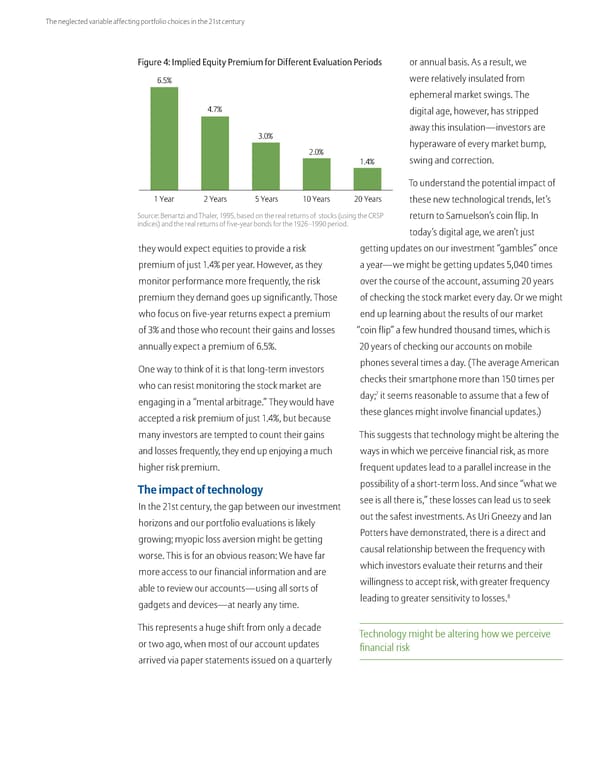The neglected variable affecting portfolio choices in the 21st century Figure 4: Implied Equity Premium for Different Evaluation Periods or annual basis. As a result, we 6.5% were relatively insulated from ephemeral market swings. The 4.7% digital age, however, has stripped away this insulation—investors are 3.0% hyperaware of every market bump, 2.0% swing and correction. 1.4% To understand the potential impact of 1 Year 2 Years 5 Years 10 Years 20 Years these new technological trends, let’s Source: Benartzi and Thaler, 1995, based on the real returns of stocks (using the CRSP return to Samuelson’s coin flip. In indices) and the real returns of five-year bonds for the 1926–1990 period. today’s digital age, we aren’t just they would expect equities to provide a risk getting updates on our investment “gambles” once premium of just 1.4% per year. However, as they a year—we might be getting updates 5,040 times monitor performance more frequently, the risk over the course of the account, assuming 20 years premium they demand goes up significantly. Those of checking the stock market every day. Or we might who focus on five-year returns expect a premium end up learning about the results of our market of 3% and those who recount their gains and losses “coin flip” a few hundred thousand times, which is annually expect a premium of 6.5%. 20 years of checking our accounts on mobile One way to think of it is that long-term investors phones several times a day. (The average American who can resist monitoring the stock market are checks their smartphone more than 150 times per 7 engaging in a “mental arbitrage.” They would have day; it seems reasonable to assume that a few of accepted a risk premium of just 1.4%, but because these glances might involve financial updates.) many investors are tempted to count their gains This suggests that technology might be altering the and losses frequently, they end up enjoying a much ways in which we perceive financial risk, as more higher risk premium. frequent updates lead to a parallel increase in the The impact of technology possibility of a short-term loss. And since “what we In the 21st century, the gap between our investment see is all there is,” these losses can lead us to seek horizons and our portfolio evaluations is likely out the safest investments. As Uri Gneezy and Jan growing; myopic loss aversion might be getting Potters have demonstrated, there is a direct and worse. This is for an obvious reason: We have far causal relationship between the frequency with more access to our financial information and are which investors evaluate their returns and their able to review our accounts—using all sorts of willingness to accept risk, with greater frequency leading to greater sensitivity to losses.8 gadgets and devices—at nearly any time. This represents a huge shift from only a decade Technology might be altering how we perceive or two ago, when most of our account updates financial risk arrived via paper statements issued on a quarterly
 The Neglected Variable Affecting Portfolio Choices in the 21st Century Page 4 Page 6
The Neglected Variable Affecting Portfolio Choices in the 21st Century Page 4 Page 6